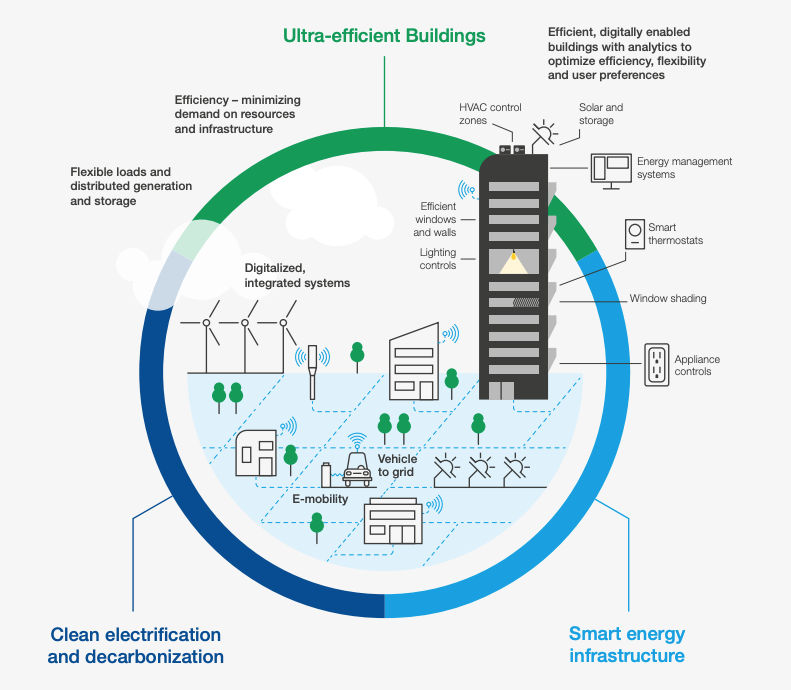4 expert views on how to accelerate investment in green buildings and decarbonize cities

Sustainable finance is improving access to affordable capital for building upgrades and retrofits.
Image: Unsplash.
Vincent Minier
Vice-President, Global Strategy and Sustainability, Energy Transition Research, Schneider ElectricStay up to date:
Real Estate
Listen to the article
- Cities are major carbon emitters and with urban populations set to rise it's imperative we decarbonize existing and future buildings.
- Some city stakeholders are taking action towards this global effort but the scale of investment must be accelerated.
- Four experts shared their thoughts on how to boost investment in greener buildings to help future-proof cities.
With the recent focus on climate change, carbon emissions, and COP26, we should not be surprised to hear that cities – with their high-rise buildings and traffic jams – account for over 70% of global carbon emissions.
Whether you’re reading this in Mumbai, Glasgow or Boston, you’re probably doing so from an office, home, or shopping mall – all of which consume energy and emit CO2 in amounts that must be reduced, while maintaining public services and improving quality of life for citizens.
We invited four experts to share their perspectives on how to accelerate investments into greener and more future-proof buildings.
Rebecca Cameron, Net Zero Carbon Built Environment, City of Cape Town
Cities and government building owners hold multiple perspectives when setting requirements for investment in decarbonization technology. These include the direct benefits of cost savings, energy efficiency and carbon reduction, along with the broader socio-economic and utility-scale implications of these investments, such as opportunities for job creation, inclusivity and access, green technology business development, and increased utility efficiency and flexibility. Importantly, these benefits occur across the scales of the built environment, from individual buildings and precincts to city-wide utility networks.
No building is an island; each operates within a complex series of systems: social, economic, environmental, governance and utility. It is therefore necessary to consider the role of each building within the broader built environment ecosystem of a city to realize the holistic value of investment in decarbonization technologies.
The direct benefits of [investing in decarbonization technology] include cost savings, energy efficiency and carbon reduction, along with the broader socio-economic and utility-scale implications.
”Cities and private sector building owners must cooperate on matters of policy, tariff structures, and open technology standards to allow for greater systems integration and localization. This can enable more flexible, inclusive and resilient municipal energy utility systems needed to support greater roll-out of local renewable energy supply. With this in place, public and private sector building owners can both contribute meaningfully to transform our cities to be more sustainable, climate-resilient and equitable.
Learn more about the City of Cape Town’s climate and energy work and how we are partnering with residents and businesses through the Let’s Act Campaign and recently launched Climate Change Strategy and Action Plan.
Justin Travlos, Global Head of Responsible Investment, AXA IM Real Assets
Investment starts with understanding and pricing risk. The dual impacts of decarbonization and climate change are reshaping the investment landscape and altering a broad set of known risks, from asset liquidity to reputational risk. As costs associated with these changes in risk become better understood, activity accelerates.
In driving decarbonization, the active decoupling of profitability from carbon and fossil-fuel reliance remains a complex proposition from a purely cost-based perspective, but the value trajectory is clear. Assets that rely heavily on fossil fuels, or which generate significant emissions, will face increasing costs, reduced liquidity, accelerated obsolescence and constrained access to institutional capital in the future. For real estate, this means reassessing not only the operating impact of the asset, but increasingly the embodied cost of creating that asset.
To accelerate investment in decarbonization there must be a growing understanding of the very real costs against which returns now need to be measured.
”Real estate has long focused on reducing operating emissions and increasing energy efficiency. This best practice has yielded improved returns, generally for low capital expenditure, and such improvements are now further optimized via new digital technologies, delivering greater efficiencies at lower cost with better user outcomes.
However, to achieve net-zero targets, greater investment and more active engagement across the broader real estate sector is now required to make the necessary changes to building systems and fabric to reach increasingly stringent performance levels. To accelerate investment into decarbonization requires a growing understanding of the very real costs against which returns now need to be measured. These costs are becoming increasingly clear as regulations unfold, and disclosure requirements increase.
What is the Forum doing to help cities to reach a net-zero carbon future?
James Middling, Global Sector Leader for Built Environment and David Robinson, Associate for Net Zero & Sustainability, Mott MacDonald
Environmental, social and governance (ESG) values are now a mainstream and integral part of the real estate world, considered by both private equity and institutional investors in the selection of assets. But what value does decarbonizing buildings create for asset owners? The answer is evidently quite a lot.
When done right, decarbonization not only addresses global environmental challenges, but can also provide OPEX savings, enhance resilience to regulatory changes and transitional risk, and generate higher asset value. It is often forgotten that decarbonization can also deliver value through less tangible co-benefits including social equity and health and well-being of building tenants and employees.
The growth of sustainable finance globally has improved access to more affordable capital for building upgrades and retrofits.
”The growth of sustainable finance globally has improved access to more affordable capital for building upgrades and retrofits. Our studies have shown that operational carbon reduction exceeding 50% in existing commercial buildings are potentially feasible through upgrades to fabric, lighting, and heating/cooling systems, while maintaining attractive returns on investment. Asset owners can expect increased rental value from energy efficiency improvements.
Some of London’s most energy-efficient offices have achieved up to a 12% rental premium. Additionally, various studies from the US market have demonstrated premiums of up to 26% in the commercial sector.
Large asset owners with corporate decarbonization strategies can enhance their brand value with a greener outlook, helping to retain and attract like-minded clients and staff – the impact of which cannot be underestimated. Indeed, the risk of being branded a carbon dinosaur may be the biggest cost of all.
Victoria Burrows, Director, Advancing Net Zero, World Green Building Council
Achieving the 1.5C ambitions of the Paris Agreement requires nothing less than a complete transformation in the way we design, build, operate, deconstruct, and value our buildings and infrastructure. The financial input will be monumental — new sustainable buildings alone are set to represent a $24.7 trillion investment opportunity in emerging markets by 2030, therefore tackling barriers to mass market engagement is essential.
The evolving scope of sustainability must broaden our perception of “green” to be closer aligned with the UN Sustainable Development Goals, and the rise in social value as not just a consideration, but a business driver for developers and investors. World Green Building Council's new flagship report, Beyond the Business Case, demonstrates the irrefutable, evidence-based, co-benefits for investing in a sustainable built environment, across both the financial and social value case.
New sustainable buildings alone are set to represent a $24.7 trillion investment opportunity in emerging markets by 2030.
”Driving investment toward sustainable buildings requires an integrated approach from the whole value chain to transition from commitments to execution and impact. Decision-makers have the power to accelerate the building sector’s sustainability transformation by capitalizing on economic opportunities, mitigating risk, and embracing the creation of social value.
With a pragmatic framework, this move from commitment to action can be accelerated to create economic opportunities for green assets, including greater access to investment, enhancing corporate reputation, increasing asset value and investment resilience, decreasing capital and operational costs, and providing return on investment to the asset owner.
This blog is part of the workstream in the Building Value Framework of Net Zero Carbon Cities initiative in collaboration with Accenture. Read more about Net Zero Carbon Cities
Don't miss any update on this topic
Create a free account and access your personalized content collection with our latest publications and analyses.
License and Republishing
World Economic Forum articles may be republished in accordance with the Creative Commons Attribution-NonCommercial-NoDerivatives 4.0 International Public License, and in accordance with our Terms of Use.
The views expressed in this article are those of the author alone and not the World Economic Forum.
Related topics:
Forum Stories newsletter
Bringing you weekly curated insights and analysis on the global issues that matter.
More on Urban TransformationSee all
Ridwan Sorunke and Alyse Schrecongost
August 25, 2025
Charlotte Edmond and Rebecca Geldard
August 19, 2025
Luis Antonio Ramirez Garcia
August 11, 2025
Michael Fröbel and Stanislas Hillen
August 8, 2025




